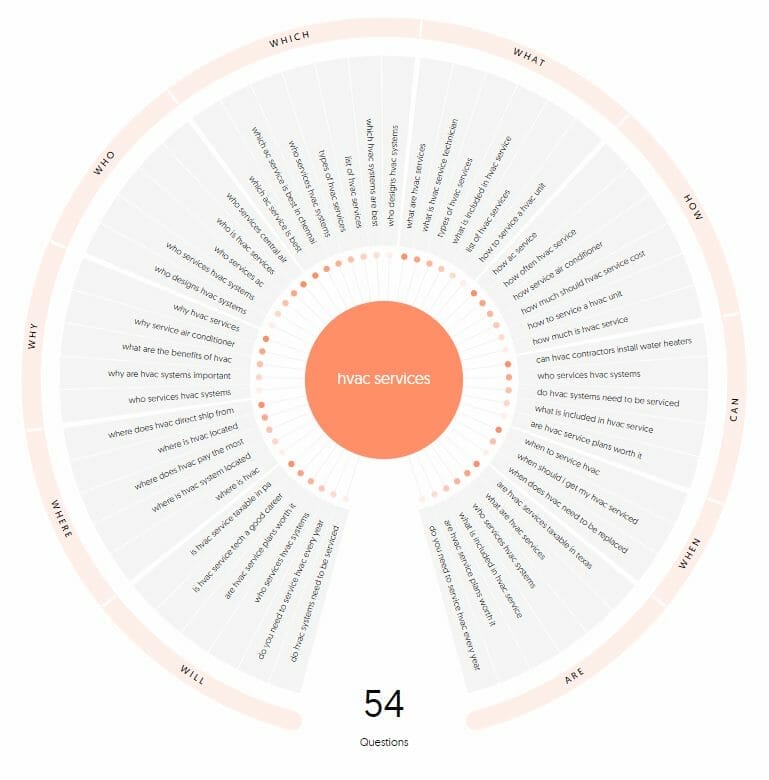People used to look for HVAC contractors on Yellow Pages, now the majority of people use search engines like Google or Bing. But despite the information they can easily get, people don’t usually scroll past the first page of search results. That’s where SEO comes in. You need to rank high and we’ll show you how. In this blog, we’ll share with you effective techniques on how to do SEO for HVAC Companies that will surely help you get tons of traffic, lots of potential leads, and rank high on local search results!
Table of Contents
ToggleWhat is SEO?
Search Engine Optimization (SEO) is the process of making sure that your HVAC website gets found on search engines. It’s all about improving the quality of your site so that your potential customers can easily find you not just on top of search results that are relevant to HVAC services, but also on local listings, and even on Google Maps!
There are three types of SEO which are On-page SEO, Off-page SEO, and Technical SEO.
On-page SEO refers to the process of improving the quality of your HVAC web pages which includes using relevant keywords and optimizing your title tags, and meta descriptions, while Off-page SEO is all about improving the quality of your website by taking specific actions that can be done outside your website. This includes acquiring backlinks, social media marketing, and gathering reviews.
Lastly, Technical SEO is where you optimize the technical aspects of your HVAC website which includes fixing broken pages, fixing pages that cannibalize other pages within your website, and a lot more in the later part of this blog.
Want to start doing SEO for your HVAC website but don’t have time to do it?
Why SEO for HVAC Companies?
It drives more traffic to your site.
As you optimize every element on your HVAC website, you’re increasing the chances of getting discovered by customers who are interested in HVAC services no matter what stage they are in the buying cycle (e.g. awareness stage, consideration stage, or decision stage). This increased visibility will result in getting more clicks, and calls, and could even help you get potential customers!
It builds your HVAC company’s credibility
Another advantage of implementing SEO strategies to your website is that it helps establish your customer’s trust. If they always see your website on top of the search results page whenever they are looking for solutions on how to solve their HVAC concerns, it’ll give them the impression that you’re a reliable source of information. As a result, you will get lots of backlinks which helps you rank higher on search results!
It’s a long-term strategy
Although the results of your SEO efforts don’t happen overnight when done right, the Return on Investment (ROI) will be worth the wait. You just have to make sure that the strategies you use are properly aligned with your HVAC company’s goals and that you stay updated with the latest Google algorithm.
Got questions about SEO for HVAC companies?
How to do SEO for HVAC Companies
Now that you have an idea of how important SEO is for your HVAC website, we’ll proceed with the effective strategies that will help you in doing On-page SEO, Off-page SEO, and Technical SEO.
On-page SEO techniques
In this section, we’ll walk you through the steps on how to do On-site SEO.
1. Optimize your URL slugs, Title tags, and meta descriptions

Uniform Resource Locator (URL) refers to the web address of your HVAC website. One of its purposes is to help search engines like Google, to have a better understanding of your website. On the other hand, the URL slug is a part of your website’s URL which tells search engines and page visitors what a specific page is all about.
SEO best practices for URLs
- Easy-to-read structure
- Having a URL that’s readable is one of the important factors in providing a good user experience.
- If your URL is written like https://www.example.com/index.php?id_fdm=425&%74rfsjd it will be confusing for page visitors to identify whether they’re on the right page or not.
- Instead of using URLs like the example above, make them readable like this https://www.example.com/cooling/ac-maintenance/
- Having a URL that’s readable is one of the important factors in providing a good user experience.
- Should have 1-2 important words from your focus keyword
- 64% of the top-ranking websites have their focus keywords in their URLs. Because of that, you should also apply this to your HVAC URLs for best results.
- Don’t use unsafe characters
- This includes <,>,%, {,}, |, [, ],`,~, and ^
- Use hyphens to separate words
- Google recommends hyphens instead of spaces and underscores when separating words in the URL because it’s easier for web crawlers to index the content on your website.
- Avoid using stop words
- Using stop words such as ” a”, “an”, and “the” makes your URL slugs longer. If it still makes sense without the stop words, just remove it.
- Don’t use the current year on your URLs (it can get easily outdated)
Title tags are used to identify the main topic of your web pages. It can be seen on your browser tabs, in search results, and even when shared on social media.
SEO best practices for Title tags
- Start your title with your focus keyword
- Use long-tail keywords. Adding modifiers to your titles increases your chance of ranking high in search results
- Don’t keyword-stuff your title
- The title should be relevant to the content of your webpage
- Use the focus keyword at the beginning of your title
- Should have a positive or negative sentiment word (this will help you get more clicks)
- Use power words (to trigger the emotional response of your target audience)
- If possible, add a number to your title (e.g. 10 Air Conditioner Maintenance Tips). This can help you get more shares and increase your engagement rate.
Meta descriptions serve as a short summary of what a page from your HVAC is all about. You can see this below the title tag on the search results page.
SEO best practices for Meta descriptions
- Meta descriptions should be unique for each HVAC page
- Recommended length of 155-160 characters
- Add a call-to-action (e.g. Call Us Now)
- Should have your focus keyword in it so that Google gets used to it
2. Use the relevant keywords in the right places
Another on-page technique that you should try is implementing relevant keywords on your website. This includes your headings, title tags, meta descriptions, image file name, alt-tags (as long as it makes sense), and throughout your content.
You should also include relevant keywords throughout your content and long-tail keywords in your title (to increase the chances of ranking on relevant search queries) because it would be impossible to rank for highly competitive keywords than specific ones.
Here’s a list of where you can find relevant keywords to your HVAC business:
- Google’s Keyword Planner

- Google’s Auto-complete suggestions

- Related Searches Section

- Answer The Public

Steps on how to do manual keyword research:
Step 1: On your preferred search engine, type in the keyword you want to use on the blog that you’re planning to create. In this example, let’s use “HVAC maintenance tips for homeowners.”
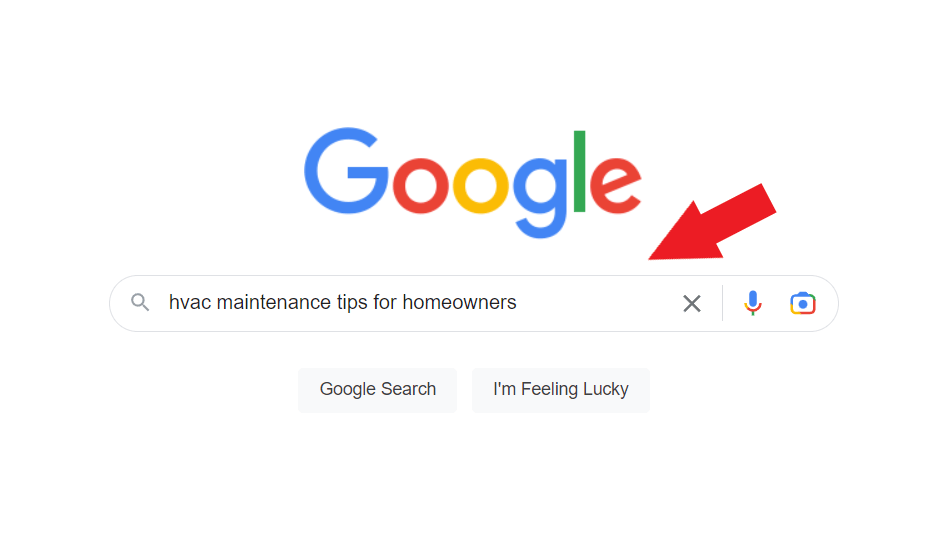
Step 2: Then, from the search results page, you’ll have an idea of the type of content that ranks for the keyword you are going for. You’ll see if most of the results are long-form articles, category pages, Top-10 best lists, and the like. Remember that when you start creating content for your HVAC website, it should satisfy what the searchers are looking for.
Go through each post on the search results page. In this example, let’s check the content of the blog that ranks #1 for the keyword “HVAC maintenance tips for homeowners.”
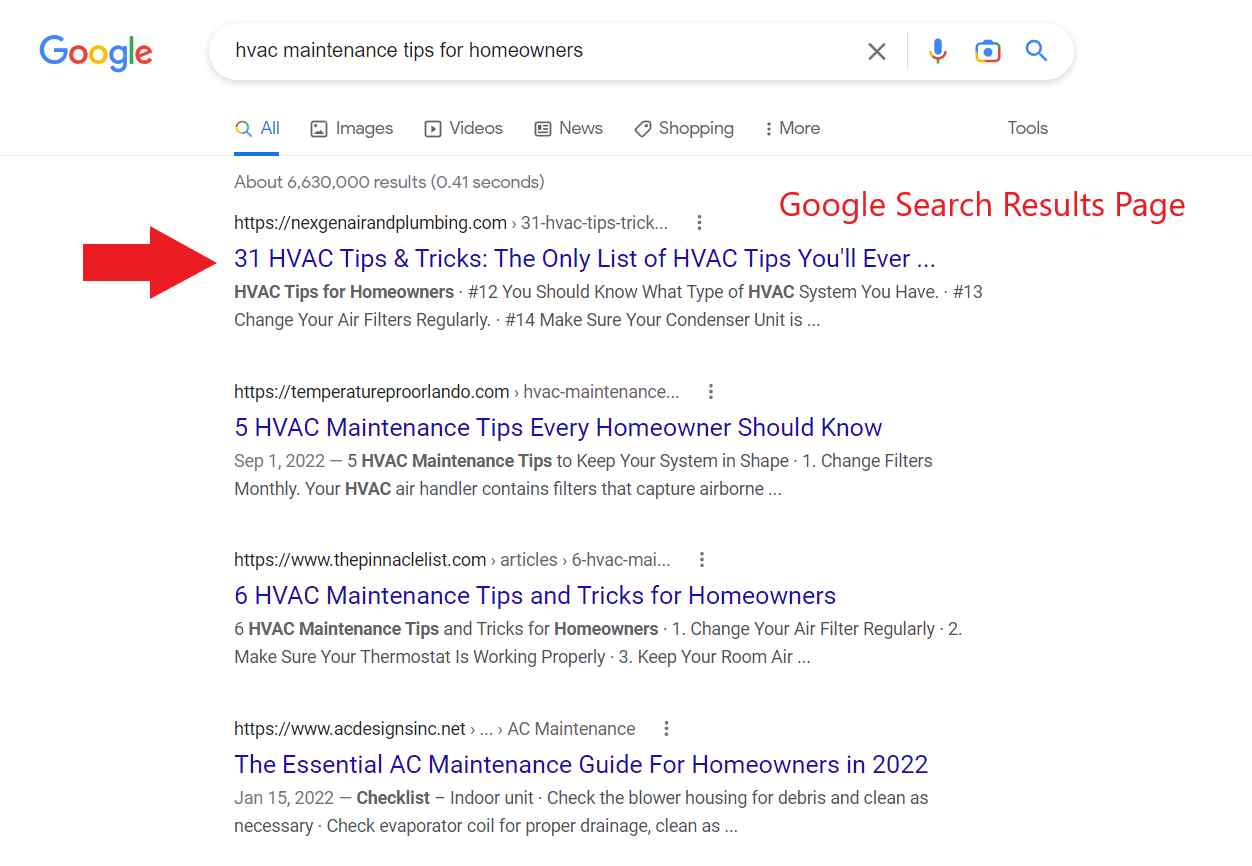
Step 3: Then, press Ctrl + F followed by your chosen keyword.
For example, if you want to check how many times the phrase “HVAC tips” was used, type in that word and press enter. It’ll show you the keyword density along with the specific areas where the phrase was used throughout the content.
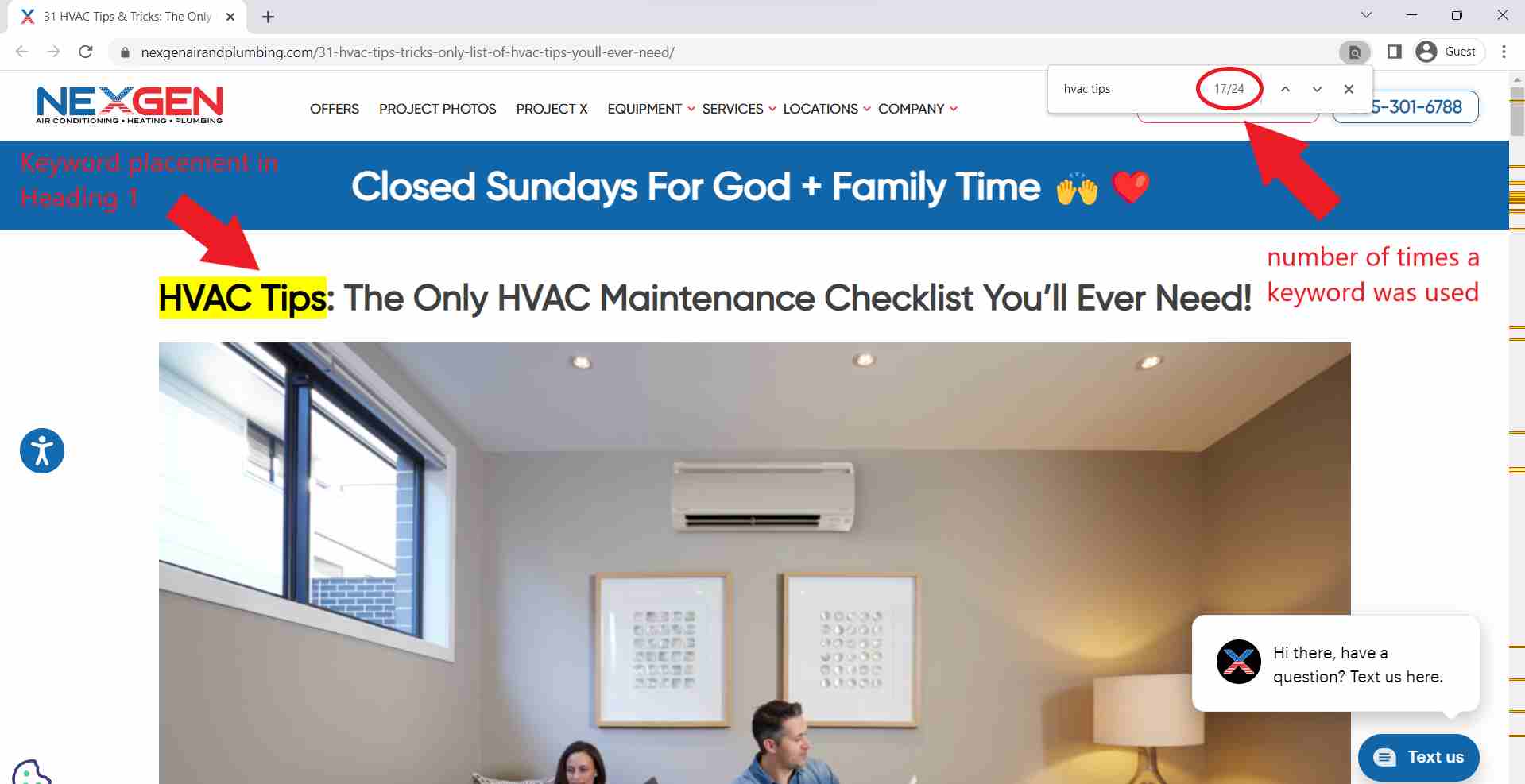
Step 4: Repeat the same steps for the rest of the pages shown on the search results. Once you’ve gathered enough data, you can apply those strategies to your HVAC articles.
3. Content Marketing

Since your target audience is the ones who are interested in HVAC services, you should publish content that is related to heating, ventilation, and air conditioning concerns. This could be in the form of blog posts, videos, infographics, or e-books. Some of the topics that you should cover include the common problems faced by your customers, ways how to fix them, how to maintain them when the season changes, etc.
SEO Best practices for content marketing:
- Compress images before uploading
- Regularly update your posts (especially blog posts)
- Use SEO-friendly URLs
- Use relevant keywords and variations throughout your content
- Use the table of contents to make your blogs easier to navigate
- Don’t forget to use internal and external links
- Incorporate evergreen content in your blogs (e.g. listicles, top tips, step-by-step guides)
Want to start publishing content on your website but running out of ideas to post? Check out our blog about Content marketing for HVAC companies to learn more.
4. Use internal and external links

Internal links refer to the links that can be found within your website. This is used if you want to recommend relevant content on your HVAC website to your page visitors and help web crawlers find a page on your site. You can use internal links on your call-to-action buttons, logos, and anchor texts.
On the other hand, external links are the ones you use if there are resources that you think would be helpful for your page visitors (if they want to read more information about a specific topic) that can be found outside your website. You can use external links through hyperlinks or images from other websites.
Having these kinds of links on your website is important because it helps increase the rank of your pages and makes you more credible to search engines.
Internal links best practices for SEO
- Create tons of relevant content on your HVAC website
- Use at least 3-4 internal links per post
- Links used should be relevant to the post that you are writing about
- Make sure you’re adding internal links to add context, not to spam your readers with irrelevant links
External links best practices for SEO
- Only link to relevant and reputable websites
- Use keyword anchor texts instead of phrases like “click here” or “this post”
- Use external links if you mention software, used images from an original source, or link out data
- Make sure it opens to a new tab. This way, you don’t lose the page visitor even after they click on a link from your post.
5. Resize images
Visual information is much easier to understand than walls of text. Aside from that, adding images to your posts makes your content readable and easy to consume.
However, one of the most common reasons behind slow websites is having large image file sizes. Images that are displayed in high-resolution consume tons of bandwidth as it loads. To fix that, you should compress images (without ruining their quality) before uploading them on your website.
You can use image compression tools like Compress Now. This software allows you to choose the compression level of your images.
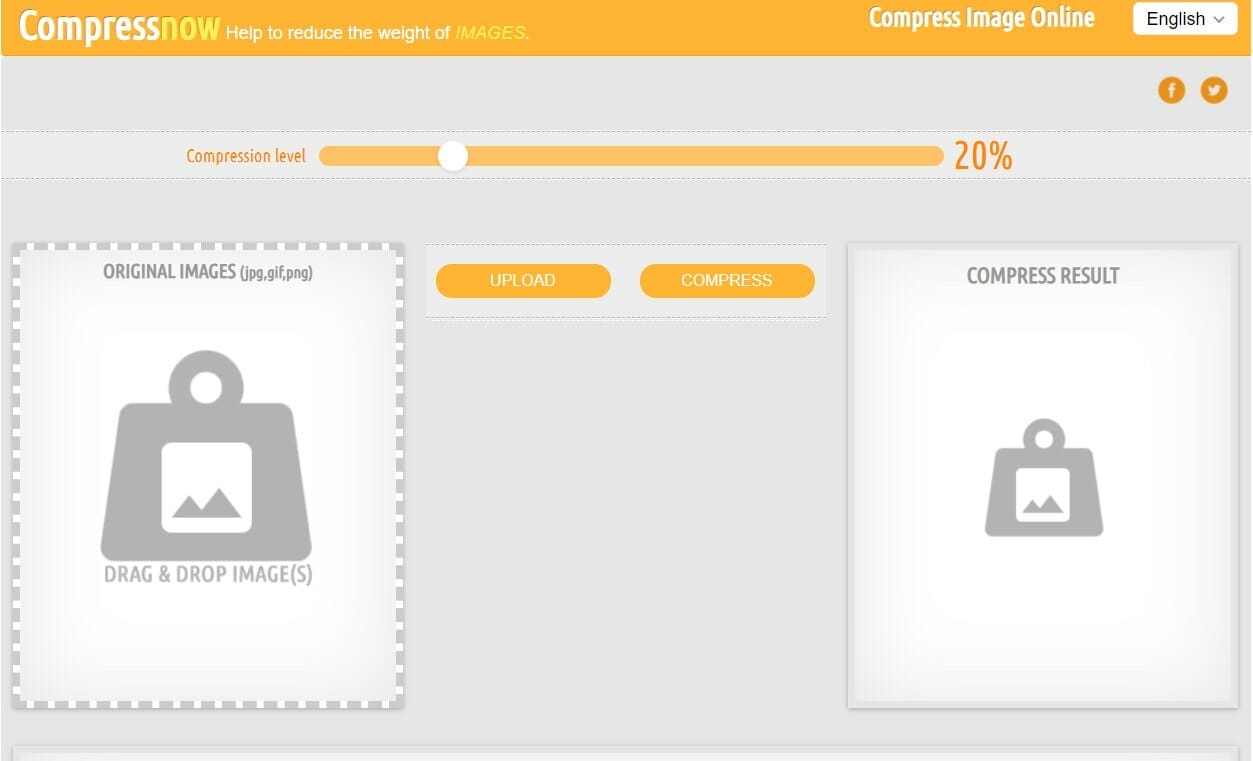
6. Proper use of alt-tags
Alt-tags also called “alt-text” refer to the description of images used on your HVAC website. Its main purpose is to help individuals with visual impairment to understand the images you used on your webpage or tell page visitors what it’s all about in case the image fails to load.
How to optimize your alt-tags:
- Use relevant keywords (if possible)
- Keep it short but descriptive. Recommended length: 125 characters
- Don’t stuff your alt-tags with too many keywords
- Don’t start with “image of” or “photo of.” It’s already understood that you are describing an image.
- Should add context to the article you are writing
Here’s an example of a well-written alt-tag:
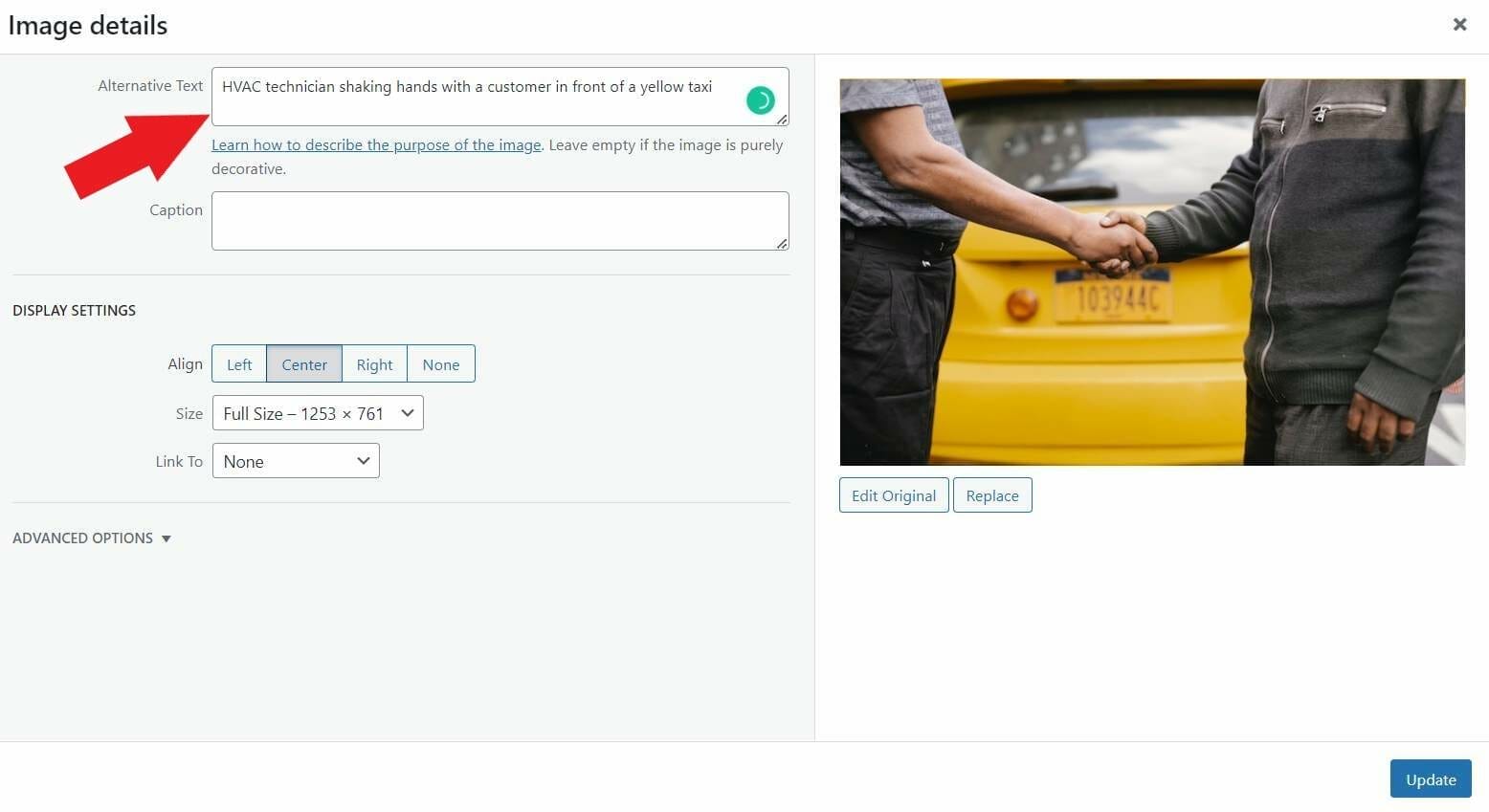
7. Use a responsive website design
Having a functional web design means that your HVAC website looks good no matter what device is used by your page visitors. For example, if you visit a website using your phone, it automatically adjusts so it perfectly fits the screen of your phone and all of the links and buttons are functionally working.
Using a responsive design will give you lots of benefits such as making your site load faster, making it easier for users to find the page they are looking for on your HVAC website, and encouraging them to stay longer on your site. By providing a positive user experience to your page visitors, it could even help you turn page visitors into your actual customers!
Need help creating a responsive website design for your HVAC company?
Off-page SEO techniques
In this section, we’ll walk you through the steps on how to do Off-site SEO.
1. Acquire backlinks
Backlinks refer to the links that “link back” to your website. It’s one of the most important factors in SEO because the number of backlinks you get is one way of telling you that you are providing valuable content to your target audience. Aside from that, it’s also one of the most effective link-building techniques which can help your HVAC site get more traffic.
Tips on how to get backlinks:
- Write valuable content
- Long-form content (e.g. lengthy blog posts, step-by-step guides, tutorials, e-books, etc.) tends to get more backlinks than short ones. But before writing lengthy articles, make sure to do research on the topics that have already been published. You want to write something that has a unique approach and opens your readers to a new perspective.
- Find guest blogging opportunities
- Guest posting is when you write an article on other websites. Its main purpose is to improve brand awareness and get referral traffic.
- Here are some keywords that you can use to find websites that accept guest contributors:
- your focus keyword + write for us
- your focus keyword + guest author
- your focus keyword + guest blogging guidelines
- your focus keyword + contributor guidelines
- Once you find a website that gives you an opportunity to write guest posts, here are the things that you should do:
- Carefully read the guidelines
- Make sure that you are writing a post to provide a valuable source of information and not to advertise your business (if you want to mention something about your business it can be added to the author’s bio)
- Make sure to format your post like the previous blogs posted on their website
- Use internal links to show the website owner that you are familiar with their content or you can use Google to find relevant blogs on their site by typing site: domain.com intitle: keyword
- Keep track of results. This will let you know if the performance of your guest blog is effective in driving additional traffic to your HVAC website.
- Create visual content
- Aside from blog posts, you could also get lots of backlinks by creating visual content like infographics. You can post them directly on your HVAC website, and on social media platforms like Pinterest (to get more traffic).
- Here are the elements that your infographic should have to gain backlinks:
- It should have reliable and well-researched information.
- It should be visually appealing.
- Some of the platforms where you can create infographics are Canva, Visme, and Venngage.
- Engage on forums
2. Get your HVAC company listed on business directories
Next is claiming your HVAC business listing on directories like Google My Business, Facebook, and Yelp. Aside from improving your HVAC company’s visibility, it also helps in SEO because, with an optimized Business profile, you get to provide valuable information to potential customers and show up on relevant local searches.

Want to learn how to claim a business on Google? Check out our blog Google My Business for HVAC Companies to learn more.
3. Social media marketing

Consumers, whether they are looking for HVAC services or not, most of them are always on social media. With over 4.26 billion social media users in the world, posting on this platform will surely help you get discovered by your potential customers. For your HVAC company to show up on your target audience’s newsfeed or timeline, you should follow these tips:
- Make sure to fill out all the needed information on your social media profiles
- Interact with your audience (e,g, like and share mentioned posts, comment on their posts about your HVAC services)
- Post relatable content to your target audience
- Use relevant keywords in your captions (e.g. HVAC services you provide, your business name, and location)
- Use different types of hashtags (e.g. niche hashtags, industry hashtags, location hashtags, branded hashtags, etc.)
- Find the best time to post
- Check which types of posts get more engagement and help you get more leads or referrals
- Stay updated with the latest algorithm
4. Gather lots of good reviews
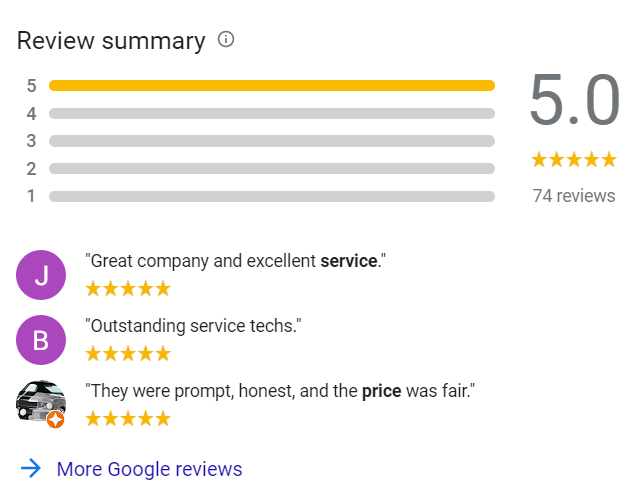
54.7% of consumers read online reviews before purchasing a product or service. It’s because online reviews serve as a guide to whether engaging themselves with your brand is worth it or not.
In fact, according to Google, businesses that have lots of positive reviews have a chance of ranking high on local searches. So, if you don’t yet have that many reviews on your Business profiles, you should probably start collecting them.
Want to know several ways how to ask your customers for reviews? Check out our blog on How to get reviews for HVAC companies to learn more.
Technical SEO techniques
The main goal of technical SEO is to make it easier for search engines like Google to crawl and index your HVAC web pages. In this section, we’ll share with you the technical aspects that you can optimize on your website.
But first, what makes a technically optimized website?
- It should have a fast page loading speed
- All of your pages should be easy to navigate (crawlable for search engines)
- No error pages found
- It doesn’t have duplicate content
- Website is secure
1. Optimize page loading speed
Another thing that you should check when optimizing the technical aspects of your HVAC website is your page loading speed. According to a study, the first five seconds of your page loading time is crucial to your page visitors. The longer your page takes to load the higher chances a page visitor will leave your site without performing any action.
Possible reasons why you have a slow page loading speed are the following: (1) you are using a poor web hosting platform, (2) you have too many large file sizes, or (3) you have too many plugins.
How to speed up your page loading times:
- Test your page loading speed
- To test your HVAC website’s page loading speed, do an eye test. Visit your HVAC company’s website and check to see which elements on your site consume time in loading, and at the same time, you’ll have an idea of what your page visitors experience as they go through your site.
- Make your HVAC website mobile-friendly
- As of the fourth quarter of 2024, mobile devices (excluding tablets) accounted for approximately 62.54% of global website traffic. With that, it’s a no-brainer that you should be optimizing your HVAC website not just for desktop users but also for mobile.
- Here are ways how to do it:
- Use at least 16px for your font sizes.
- Make your call-to-action buttons visible.
- Use a hamburger menu to avoid clutter on your pages.
- Remove or lessen the number of pop-ups used on your website. It can sometimes be intrusive especially if the exit button is not responsive.
- Make sure that your page visitors have the option to switch from mobile to desktop view.
- Don’t use cheap hosting
- Most of the cheap hosting platforms deliver poor performance to their users such as very slow page loading times. Instead of saving money, you are more likely to spend more because of its bad service. Because of that, we recommend that you choose a reputable hosting platform that guarantees to provide you with a fast server, 24/7 chat support, and most importantly, provides an extra layer of security that encrypts sensitive information from your server to the user’s browser.
- Remove unnecessary plugins
- From time to time, you should check the plugins you have on your website. Check to see if there are plugins that you are no longer using as it may be another reason why your website loads too slowly. You can either disable or remove plugins that are no longer needed.
- Reduce the number of redirects from your site
- Redirects are made due to several reasons (1) because a page from your site is broken, (2) you’re performing maintenance on your site, (3) you migrated your site from HTTP to HTTPS, or (4) you moved out from your old website. If you can, as much as possible, avoid using too many redirects.
2. Improve your website’s crawlability and indexability

Crawlability refers to the ability of search engines to scan and index your HVAC pages while indexability refers to your page’s ability to be indexed by search engines. Without these two factors, it would be impossible for you to get organic traffic.
Tips on how to improve your website’s indexability:
- Submit your sitemap on Google Search Console
- Sitemaps is a file that contains all of the direct links on your website. Its main purpose is to help Google understand your HVAC website structure. Adding it to Search Console will help you get notified whenever there are updates about it
- Improve your linking strategy
- The way you use your internal links also affects crawlability. Make sure that all of the content on your HVAC website is connected to relevant pages.
- Fix duplicate content
- Another issue that you might encounter especially if you are publishing blog posts on your website is keyword cannibalization. This happens when you have almost the same content throughout your HVAC blogs or two of your posts are competing for the same search query. Because of that, you’re preventing yourself from ranking high on search results.
- How to prevent keyword cannibalization on your HVAC website:
- Let’s say you have two pages that use different focus keywords. However, both are ranked under the same topic.
- You can reduce the number of focus keywords on the other blog and vice versa.
- Plan your keyword strategy. You can use tools like Ubebrsuggest or Moz Keyword Explorer
- Keep track of your keyword rankings. To check if your focus keyword is ranking for other pages on your website or if you want to check how well you’re performing compared to your competitors, use Semrush’s Position Tracking Tool. It’ll provide you with lots of useful information that will help you with your HVAC company’s SEO.

- Let’s say you have two pages that use different focus keywords. However, both are ranked under the same topic.
3. Fix broken pages or images
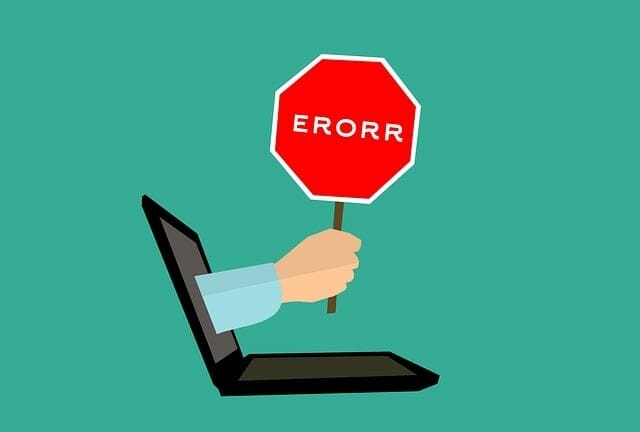
Broken pages also known as “dead links” are pages that can’t be found by page visitors. When this happens, an error message will be displayed on their screen. The possible reasons why this occurs could be one of the following:
- You’re trying to access an incorrect URL
- The external site used no longer exists
- Your URL structure has changed and you haven’t yet set a redirect
- PDF links or other content has been moved to a new location or deleted
It’s best that you detect pages on your website that have dead links before your page visitors do because it will greatly affect their user experience. Not just that but it will also affect your search rankings.
Need help finding broken links on your HVAC website? Check out Ahrefs Broken Link Checker. You’ll see results in just a few clicks.

4. Make your HVAC website secure

As of 2021, millions of websites have SSL certificates installed on their websites. Secure Sockets Layer (SSL) enables encrypted connection which prevents your customer’s data (e.g. passwords, credit card info, email address) from being stolen by third parties. The main reason why you should have this on your HVAC website is that it safeguards a user’s data that are sent between two systems.
If you are looking for a WordPress hosting platform that can help you install an SSL certificate on your HVAC website and detect or remove malware, we recommend using WPX.
Want to know how to start creating your ad campaigns? Check out our blog about Google Ads for HVAC Companies to learn more.
SEO can be time-consuming. Our digital marketing experts are here to help.
Key Takeaway
Search Engine Optimization is one of the most effective tactics that you can do to stay on top of the minds of your potential customers. Although it takes time before you see results, when done right, it could be a good long-term strategy for HVAC companies like yours. Just follow the best practices we’ve mentioned earlier and you will see tons of traffic and business opportunities coming your way.





